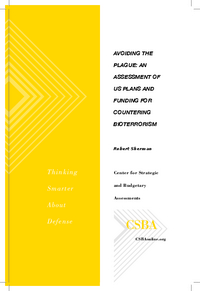
The terrorist attacks of September 11, 2001, sparked grave concern that the United States might be struck by terrorists armed with weapons of mass destruction (WMD). Typically, policymakers and analysts include nuclear, biological, chemical, and radiological weapons in this category. Of these WMD, biological agents may pose the greatest danger. Like nuclear weapons, biological weapons can, under the right circumstances, cause massive casualties. Compared to nuclear weapons, however, biological weapons may be substantially easier to acquire.
To be sure, the ease with which a terrorist group could acquire and effectively use biological weapons to inflict mass casualties has been overstated by some. Moreover, for practical reasons many terrorist groups (and perhaps most of the largest and most capable groups) may be disinclined to employ any weapon to cause mass casualties. Nevertheless, for planning purposes, it is prudent to assume that, in the foreseeable future, one or more terrorist groups will acquire the means to use biological weapons to cause mass casualties, and be inclined to launch such an attack.
Biological weapons consist of toxins, non-contagious and contagious bacteria and viruses, and, potentially, genetically-engineered “designer” agents. The most dangerous—though, in the near-term, probably least likely—biological weapon would be a contagious, highly virulent designer agent.
In order to combat the threat posed by bioterrorism, the United States is pursuing an approach consisting of the following three elements:
- Preventing terrorists from acquiring biological weapons or the means of effectively employing those weapons to cause mass casualties, through non-military means;
- Defending against a terrorist attack with biological weapons, once it has been launched, through the use of various measures capable of detecting, protecting against, and mitigating the effects of such an attack; and
- Attacking and destroying terrorists’ biological warfare capabilities through preventive or retaliatory operations.
Altogether, federal spending directly related to preventing and defending against a possible attack with biological weapons currently (fiscal year 2007) amounts to about $8 billion a year. This represents an increase of some 330 percent in real (inflation-adjusted) terms from the level of funding provided for these programs and activities prior to the terrorist attacks of 9/11. Far more is spent annually acquiring and supporting the kinds of military capabilities that might be used to conduct an attack against a bioterrorist site. However, since almost all of these capabilities would also be used to carry out combat operations against the many other targets the US military might be required to strike, these costs cannot reasonably be attributed solely to combating bioterrorism.
Adopting a multifaceted approach to combating bioterrorism makes sense. However, current policies, programs and activities do not, in some cases, adequately address the challenge posed by bioterrorism, either as that threat exists today or as it is likely to develop in coming years. It should be possible to address some of these gaps and shortfalls by shifting resources both within and between different program areas. In part, this is because a significant amount of waste and inefficiency appears to have accompanied the rapid increases in biodefense funding that occurred in the immediate aftermath of 9/11. But substantially improving U.S. efforts to combat bioterrorism will also likely require some increase in the overall level of funding provided for these programs and activities.
Given existing data limitations, the level of secrecy that understandably surrounds some areas related to bioterrorism, and other factors, it is impossible to provide a precise estimate of how much additional funding would be needed to create a substantially more robust US capability to combat bioterrorism. However, evidence suggests that an additional $1–5 billion a year might usefully be allocated to this mission, primarily to expand the development of medical countermeasures, and broad spectrum therapeutics in particular.



























